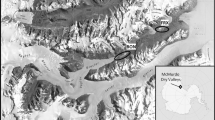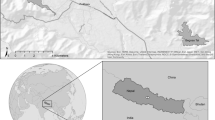Abstract
We investigated whether phytoplankton communities in two lakes in SW Greenland were phosphorus or nitrogen limited. The study lakes have contrasting water chemistry (mean conductivities differ ten fold) and are located near Kangerlussuaq, SW Greenland (~67°N, 51°W). A microcosm nutrient enrichment experiment was performed in June 2003 to determine whether nitrate or phosphate addition stimulated phytoplankton growth. Samples were analysed for species composition, biomass, and alkaline phosphatase activity (APA). Initially, both lakes had extremely low total phosphorus but high total nitrogen concentrations and high APA, suggesting that the phytoplankton were phosphorus limited prior to the start of the experiment. The phytoplankton composition and biomass (mainly Ochromonas spp.) responded to phosphate but not to nitrate addition. In both lakes, chlorophyll a increased significantly when phosphate was added. Furthermore, APA was significantly lower in the two lakes when phosphate was added compared to the control and the nitrogen addition treatment. The dominance of mixotrophic phytoplankton and high DOC values suggest that these lakes may be regulated by microbial loop processes.



Similar content being viewed by others
References
Anderson NJ, Bennike O, Christoffersen K, Jeppesen E, Markager S, Miller G, Renberg I (1999) Limnological and paleolimnological studies of lakes in south-western Greenland. Geol Greenland Surv Bull 183:68–74
Anderson NJ, Harriman R, Ryves DB, Patrick ST (2001) Dominant factors controlling variability in the ionic composition of West Greenland lakes. Arctic Antarct Alp Res 33:418–425
Andersson A, Falk S, Samuelsson G, Hagström Å (1989) Nutritional characteristics of a mixotrophic nanoflagellate, Ochromonas sp. Microb Ecol 17:251–262
Bergström A-K, Blomqvist B, Jansson M (2005) Effects of atmospheric nitrogen deposition on nutrient limitation and phytoplankton biomass in unproductive Swedish lakes. Limnol Oceanogr 50:987–994
Bettez ND, Rublee PA, O’Brien J, Millers MC (2002) Changes in abundance, composition and controls within the plankton of a fertilised arctic lake. Freshw Biol 47:303–311
Bindler R, Renberg I, Anderson NJ, Appleby PG, Emteryd O, Boyle J (2001a) Pb isotope ratios of lake sediments in West Greenland: inferences on pollution sources. Atmos Environ 35:4675–4685
Bindler R, Renberg I, Appleby PG, Anderson NJ, Rose NL (2001b) Mercury accumulation rates and spatial patterns in lake sediments from West Greenland: A coast to ice margin transect. Environ Sci Technol 35:1736–1741
Bird DF, Kalff J (1987) Algal phagotrophy---regulating factors and importance relative to photosynthesis in Dinobryon (Chrysophyceae). Limnol Oceanogr 32:277–284
Blomqvist P, Herlitz E (1996) Methods for quantitative assessment of phytoplankton in freshwaters. Part 2. Literature and its use for determination of planktonic Volvocales, Tetrasporales, Chlorococcales, and Ulotrichales, and formulas for calculation of biovolume of the organisms. Naturvårdsverkets förlag, Rapport 4861, pp 1–70
Brodersen KP, Anderson J (2002) Distribution of chironomids (Diptera) in low arctic West Greenland lakes: trophic conditions, temperature and environmental reconstruction. Freshw Biol 47:1137–1157
Caron DA, Porter KG, Sanders RW (1990) Carbon, nitrogen and phosphorus budgets for the mixotrophic flagellate Poteriochromonas malhamensis (Chrysophyceae) during bacterial ingestion. Limnol Oceanogr 35:433–443
Cembella AD, Antia NJ, Harrison PJ (1984) The utilization of inorganic and organic phosphorous compounds as nutrients by eukaryotic microalgae: a multidisciplinary perspective: part 1. CRC Crit Rev Microbiol 10:317–391
Currie DJ, Kalff J (1984) A comparison of the abilities of freshwater algae and bacteria to acquire and retain phosphorus. Limnol Oceanogr 29:298–310
Drakare S, Blomqvist P, Bergström A-K, Jansson M (2003) Relationships between picophytoplankton and environmental variables in lakes along a gradient of water colour and nutrient content. Freshw Biol 48:729–740
Ellis-Evans JC, Galchenko V, Laybourn-Parry J, Mylnikov AP, Petz W (2001) Environmental characteristics and microbial plankton activity of freshwater environments at Kongsfjorden, Spitsbergen (Svalbard). Arch Hydrobiol 152:609–632
Elser JJ, Marzolf ER, Goldman CR (1990) Phosphorus and nitrogen limitation of phytoplankton growth in the freshwaters of North America: a review and critique of experimental enrichments. Can J Fish Aquat Sci 47:1468–1477
Fossing H, Cristensen PB, Dalsgaard T. Rysgaard S, Risgaard-Petersen N (2003) Sediment – intern belastning. In: Teknisk anvisning for marin overvågning-Bentiske parametre. Miljøministeriet Danmarks Miljøundersøgelser, pp 14, 1–14, 32
Gajewski K, Hamilton PB, McNeely R (1997) A high resolution proxy-climate record from an arctic lake with annually-laminated sediments on Devon Island, Nunavut, Canada. J Paleolimnol 17:215–225
Grasshoff K (1983) Determination of nitrate. In: Grasshof K, Ehrhardt M, Kremling K (eds) Methods of Seawater analysis. Verlag Chemie, Weinheim, pp 143–150
Guildford SJ, Hecky RE (2000) Total nitrogen, total phosphorus, and nutrient limitation in lakes and oceans: Is there a common relationship. Limnol Oceanogr 45:1213–1223
Hansen K (1967) The general limnology of arctic lakes as illustrated by examples from Greenland. Meddelelser om Grønland 178:1–77
Healey FP, Hendzel LL (1979) Indicators of phosphorus and nitrogen deficiency in five algae in culture. J Fish Res Board Can 36:1364–1369
Healey FP, Hendzel LL (1980) Physiological indicators of nutrient deficiency in lake phytoplankton. Can J Fish Aquat Sci 37:442–453
Istvánovics V, Petterson K, Pierson D, Bell R (1992) Evaluation of phosphorus deficiency indicators for summer phytoplankton in Lake Erken. Limnol Oceanogr 37:890–900
Jansson M, Blomqvist P, Jonsson A, Bergström A-K (1996) Nutrient limitation of bacterioplankton, autotrophic andmixotrophic phytoplankton, and heterotrophic nanoflagellates in Lake Örträsket. Limnol Oceanogr 41:1552–1559
Jansson M, Bergström A-K, Blomqvist P, Isaksson A, Johansson A (1999) Impact of allochtonous organic carbon on microbial food web dynamics and structure in Lake Örträsket. Arch Hydrobiol 144:409–428
Jansson M, Bergström A-K, Blomqvist P, Drakare S (2000) Allochtonous organic carbon and phytoplankton/bacterioplankton production relationships in lakes. Ecology 81:3250–3255
Jespersen A-M, Christoffersen K (1987) Measurements of chlorophyll a from phytoplankton using ethanol as extraction solvent. Arch Hydrobiol 109:445–454
Jeppesen E, Jensen JP, Jensen C, Faafeng B, Hessen DO, Søndergaard M, Lauridsen T, Brettum P, Christoffersen K (2003). The impact of nutrient state and lake depth on top-down control in the pelagic zone of lakes: A study of 466 lakes from the temperate zone to the Arctic. Ecosystems 6:313–325
Kalff J (1991) Phytoplankton dynamics in an arctic lake. J Fish Res Board Can 24:1861–1971
Kettle H, Thompson R, Anderson NJ, Livingstone DM (2004) Empirical modeling of summer lake surface temperatures in southwest Greenland. Limnol Oceanogr 49:271–282
Kristiansen J (1994) Preliminary studies on the distribution of silica-scaled chrysophytes in Greenland. Verh Internat Verein Limnol 25:2234–2236
Kuenzler EJ (1965) Glucose-6-phosphate utilization by marine algae. J Phycol 1:156–164
Laybourn-Parry J, Marshall WA (2003) Photosynthesis, mixotrophy and microbial plankton dynamics in two high arctic lakes during summer. Polar Biol 26:517–524
McGowan SM, Ryves DB, Anderson NJ (2003) Holocene records of effective precipitation in West Greenland. Holocene 13:239–249
Menzel DW, Corwin N (1965) The measurement of total phosphorus in seawater based on the liberation of organically bound fractions by persulphate oxidation. Limnol Oceanogr 10:280–282
Murphy J, Riley JP (1962) A modified single solution method for the determination of phosphate in natural waters. Anal Chim Acta 27:31–36
O’Brien WJ, Bahr M, Hershey AE, Hobbie JE, Kipphut GW, Kling GW, Kling H, McDonald M, Miller MC, Rublee P, Vestal JR (1997) The limnology of Toolik Lake. In: Milner A, Oswood MW (eds) Alaskan freshwaters. Springer, Berlin Heidelberg New York, pp 61–106
Overpeck J, Hughen K, Hardy D, Bradley R, Case R, Douglas M, Finney B, Gajewski K, Jacoby G, Jennings A, Lamoureux S, Lasca A, MacDonald G, Moore J, Retelle M, Smith S, Wolfe A, Zielinski G (1997) Arctic environmental change of the last four centuries. Science 278:1251–1256
Pålsson C, Daniel C (2004). Effects of prey abundance and light intensity on nutrition of a mixotrophic flagellate and its competitive relationship with an obligate heterotroph. Aquat Microb Ecol 36:247–256'
Pettersson K (1980) Alkaline phosphatase activity and algal surplus phosphorus as phosphorus-deficiency indicators in Lake Erken. Arch Hydrobiol 89:54–87
Pla S, Anderson NJ (2005) Environmental factors correlated with chrysophyte cyst assemblages in low arctic lakes of south-west Greenland. J Phycol 41:957–974
Redfield AC (1958) The biological control of chemical factors in the environment. Am Sci 46:205–221
Rengefors K, Ruttenberg KC, Haupert CL, Taylor C, Howes BL, Anderson DM (2003) Experimental investigation of taxon-specific response of alkaline phosphatase activity in natural freshwater phytoplankton. Limnol Oceanogr 48:1167–1175
Reynolds CS (1984) The ecology of freshwater phytoplankton. Cambridge University Press, Cambridge
Rhee G-Y (1972) Competition between an algae and an aquatic bacterium for phosphate. Limnol Oceanogr 17:505–514
Rothhaupt KO (1996) Utilization of substitutable carbon and phosphorus sources by the mixotrophic chrysophyte Ochromonas sp. Ecology 77:706–715
Rühland K, Priesnitz A, Smol JP (2003) Paleolimnological evidence from Diatoms for recent environmental changes in 50 lakes across Canadian arctic treeline. Arctic Antarct Alp Res 35:110–123
Ryves DB, McGowan S, Anderson NJ (2002) Development and evaluation of a diatom-conductivity model from lakes in West Greenland. Freshw Biol 47:995–1014
Sanders RW, Caron DA, Davidson JM, Dennet MR, Moran DM (2001) Nutrient acquisition and population growth of a mixotrophic alga in axenic and bacterized cultures. Microb Ecol 42:513–523
Serreze MC, Walsb JE, Chapin FS, Osterkamp T, Dyurgerov M, Romanovsky V, Oechel WC, Morison J, Zhang T, Barry RG (2000) Observational evidence of recent change in the northern high-latitude environment. Clim Change 46:159–207
Sorvari S, Korhola A, Thompson R (2002) Lake diatom response to recent Arctic warming in Finnish Lapland. Global Change Biol 8:171–181
Stockner JG (1991) Autotrophic picoplankton in freshwater ecosystems: the view from the summit. Int Rev ges Hydrobiol 76:483–492
Stockner JG, Antia NJ (1986) Algal picophytoplankton from marine and freshwater ecosystems: a multidisciplinary perspective. Can J Fish Aquat Sci 43:2472–2503
Valderrama JC (1995) Methods of nutrient analysis. In: Hallegraeff GM, Anderson DM, Cembella AD (eds) Manual of harmful marine microalgae. IOC Manuals and guides No 33, UNESCO, pp 251–268
Vincent WF (1981) Rapid physiological assays for nutrient demand by the plankton. II. Phosphorus. J Plankton Res 3:699–710
Williams WD (1991) Comments on the so-called salt lakes of Greenland. Hydrobiologia 210:67–74
Wolfe AP, Baron JS, Cornett RJ (2001) Anthropogenic nitrogen deposition induces rapid ecological changes in alpine lakes of the Colorado Front Range (USA). J Paleolimnol 25:1–7
Acknowledgements
The fieldwork was supported by a grant to NJA by the Danish Natural Science Research Council (SNF). The project was sponsored by the Biology Education Program for Master’s Theses, Lund University. H. Perren, B. Perren, P. Christiansen are gratefully thanked for assistance in the field. M. Svensson is acknowledged for help with APA analyses, and C. Pålsson for identification of mixotrophic flagellates. Dr P. Carlsson helped with nitrogen analysis and provided helpful comments on the manuscript. We are grateful for the constructive comments provided by the reviewers.
Author information
Authors and Affiliations
Corresponding author
Rights and permissions
About this article
Cite this article
Brutemark, A., Rengefors, K. & Anderson, N.J. An experimental investigation of phytoplankton nutrient limitation in two contrasting low arctic lakes. Polar Biol 29, 487–494 (2006). https://doi.org/10.1007/s00300-005-0079-0
Received:
Revised:
Accepted:
Published:
Issue Date:
DOI: https://doi.org/10.1007/s00300-005-0079-0




